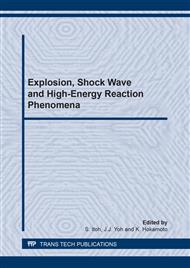[1]
M. Noguchi, K. Takahashi, Key Eng. Mater, Vol. 127-131(1997), p.53.
Google Scholar
[2]
B. Maruyama, Adv. Mater. Processes (1999), p.6.
Google Scholar
[3]
T. S. Srivatsan, E. J. Lavernia, J. Mater. Sci., 27(1992), p.5965.
Google Scholar
[4]
L. Wang, R. Arsenault,J. Metall. Trans. A22 (1991), p.3013.
Google Scholar
[5]
R. G. Munro, J. Res. Natl. Inst. Stand. Technol. Vol. 105 (2000), p.709.
Google Scholar
[6]
F. Olevsky, P. mogilevsky, E. Y. Gutmanas, I. Gotman, Metall. Trans. A 27A (1996), p. (2071).
Google Scholar
[7]
M. Oehering, T. Pfullmann and R. Bormann, Mater. Sci. Forum, Vol. 179(1995), p.435.
Google Scholar
[8]
R. A. Prummer, G. Ziegler, Powder Metall. Int., 9(1)(1985), p.1035.
Google Scholar
[9]
N. N. Thadani, Adv. Mater. Manuf. Proc., 3(4)(1988), p.49.
Google Scholar
[10]
K. Sivakumar, Y. R. Mahajan. and V. V. Bhahu Prasad, J. Powder. Metall. 28(1992), p.63.
Google Scholar
[11]
K. Hokamoto, J. S. Lee, M. Fujita, S. Itoh, K. Raghukandan, Mater. Sci. 37(2002), p.4073.
Google Scholar
[12]
K. Sivakumar, T. Balakrishna and K. Hokamoto, J. Mater. Process. Technol., (2001), p.396.
Google Scholar
[13]
K. Sivakumar, K. Hokamoto, S. Nakano and M. Fujita, in shock-wave and high strain-rate phenomena, K. P. Staudhammer, and M.A. Meyers(Eds). Elsevier, New York, (2001), p.313.
Google Scholar
[14]
H. Eskandari, K. Hokamoto, H. M. Ghasemi and M. Emamy, S. Borji, J. S. Lee, Mater. Sci. Forum, Vols. 465-466(2004), p.433.
DOI: 10.4028/www.scientific.net/msf.465-466.433
Google Scholar
[15]
H. Eskandari, H. M. Ghasemi and M. Emamy, Mater. Sci. Forum, Vols. 465 (2004), p.213.
Google Scholar
[16]
K. Hokamoto, K. Raghukandan, J. S. Lee, M. Fujita and R. Tomoshige, Mater. Sci. Forum, Vol. 437-438(2003), p.169.
DOI: 10.4028/www.scientific.net/msf.437-438.169
Google Scholar
[17]
S. Itoh, S. Kubota, A. Kira, S. Nagano and M. Fujita, J. Japan Explosives Soc., Vol. 55(1994), p.71.
Google Scholar
[18]
M. Gupta, Aluminum Transactions, Vol. 1, No 1 (1999), p.33.
Google Scholar
[19]
D. L. McDanels, Metall. Trans. A, Vol. 16 (1985), p.1105.
Google Scholar
[20]
J. W. Luster, M. Thumann and R. Baumann, Mater. Sci. and Tech., Vol. 9 (1993), p.862.
Google Scholar
[21]
R. Prummer: Fundamental Issues and Application of Shock Wave and High-Strain-Rate Phenomena (2001), p.235.
Google Scholar
[22]
K. Sivakumar and K. Hokamoto, J. Mater. Sci., Vol. 35(2000), p.5823.
Google Scholar


